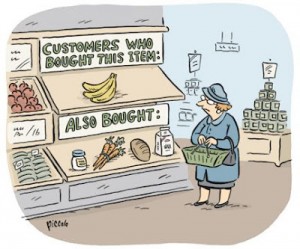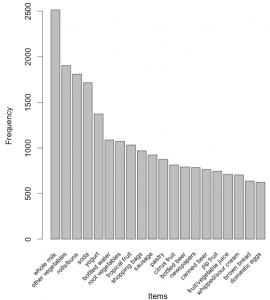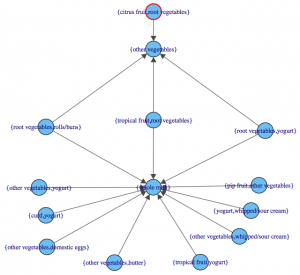Market Basket Analysis with R

Association Rules
There are many ways to see the similarities between items. These are techniques that fall under the general umbrella of https://www.alyssasmusic.ca/june-2023/ association. The outcome of this type of technique, in simple terms, is a set of rules that can be understood as click here “if this, then that”.
Applications
So what kind of items are we talking about?
There are many applications of association:
- Product recommendation – like Amazon’s “customers who bought that, also bought this”
- Music recommendations – like Last FM’s artist recommendations
- Medical diagnosis – like with diabetes really cool stuff
- Content optimisation – like in magazine websites or blogs
In this post we will focus on the retail application – it is simple, intuitive, and the dataset comes packaged with R making it repeatable.
The Groceries Dataset
Imagine 10000 receipts sitting on your table. Each receipt represents a transaction with items that were purchased. The receipt is a representation of stuff that went into a customer’s basket – and therefore ‘Market Basket Analysis’.
That is exactly what the Groceries Data Set contains: a collection of receipts with each line representing 1 receipt and the items purchased. Each line is called a follow link transaction and each column in a row represents an https://gardenswhisper.com/terms-of-service/ item. You can download the Groceries data set to take a look at it, but this is not a necessary step.
A little bit of Math
We already discussed the concept of Items and Item Sets.
We can represent our items as an item set as follows:
Therefore a transaction is represented as follows:
This gives us our rules which are represented as follows:
Which can be read as “if a user buys an item in the item set on the left hand side, then the user will likely buy the item on the right hand side too”. A more human readable example is:
If a customer buys coffee and sugar, then they are also likely to buy milk.
With this we can understand three important ratios; the support, confidence and lift. We describe the significance of these in the following bullet points, but if you are interested in a formal mathematical definition you can find it on wikipedia.
- https://www.autenticmed.com.br/parceria/ Support: The fraction of which our item set occurs in our dataset.
- https://brooklyntothecatskills.com/2020/10/20/homemade-coffee-cake/ Confidence: probability that a rule is correct for a new transaction with items on the left.
- click Lift: The ratio by which by the confidence of a rule exceeds the expected confidence.
Note: if the lift is 1 it indicates that the items on the left and right are independent. - We set the minimum support to 0.001
- We set the minimum confidence of 0.8
- We then show the top 5 rules
- The number of rules generated: 410
- The distribution of rules by length: Most rules are 4 items long
- The summary of quality measures: interesting to see ranges of support, lift, and confidence.
- The information on the data mined: total data mined, and minimum parameters.
- What are customers likely to buy before buying whole milk
- What are customers likely to buy if they purchase whole milk?
- We set the confidence to 0.15 since we get no rules with 0.8
- We set a minimum length of 2 to avoid empty left hand side items
- Snowplow Market Basket Analysis
- Discovering Knowledge in Data: An Introduction to Data Mining
- RDatamining.com
Apriori Recommendation with R
So lets get started by loading up our libraries and data set.
# Load the libraries library(arules) library(arulesViz) library(datasets) # Load the data set data(Groceries) |
Lets explore the data before we make any rules:
# Create an item frequency plot for the top 20 items itemFrequencyPlot(Groceries,topN=20,type="absolute") |
We are now ready to mine some rules!
You will always have to pass the minimum required Buy Clonazepam Online Overnight support and confidence.
# Get the rules rules <- apriori(Groceries, parameter = list(supp = 0.001, conf = 0.8)) # Show the top 5 rules, but only 2 digits options(digits=2) inspect(rules[1:5]) |
The output we see should look something like this
lhs rhs support confidence lift 1 {liquor,red/blush wine} => {bottled beer} 0.0019 0.90 11.2 2 {curd,cereals} => {whole milk} 0.0010 0.91 3.6 3 {yogurt,cereals} => {whole milk} 0.0017 0.81 3.2 4 {butter,jam} => {whole milk} 0.0010 0.83 3.3 5 {soups,bottled beer} => {whole milk} 0.0011 0.92 3.6 |
This reads easily, for example: if someone buys yogurt and cereals, they are 81% likely to buy whole milk too.
We can get summary info. about the rules that give us some interesting information such as:
set of 410 rules rule length distribution (lhs + rhs): sizes 3 4 5 6 29 229 140 12 summary of quality measures: support conf. lift Min. :0.00102 Min. :0.80 Min. : 3.1 1st Qu.:0.00102 1st Qu.:0.83 1st Qu.: 3.3 Median :0.00122 Median :0.85 Median : 3.6 Mean :0.00125 Mean :0.87 Mean : 4.0 3rd Qu.:0.00132 3rd Qu.:0.91 3rd Qu.: 4.3 Max. :0.00315 Max. :1.00 Max. :11.2 mining info: data n support confidence Groceries 9835 0.001 0.8 |
Sorting stuff out
The first issue we see here is that the rules are not sorted. Often we will want the most relevant rules first. Lets say we wanted to have the most likely rules. We can easily sort by confidence by executing the following code.
rules<-sort(rules, by="confidence", decreasing=TRUE) |
Now our top 5 output will be sorted by confidence and therefore the most relevant rules appear.
lhs rhs support conf. lift 1 {rice,sugar} => {whole milk} 0.0012 1 3.9 2 {canned fish,hygiene articles} => {whole milk} 0.0011 1 3.9 3 {root vegetables,butter,rice} => {whole milk} 0.0010 1 3.9 4 {root vegetables,whipped/sour cream,flour} => {whole milk} 0.0017 1 3.9 5 {butter,soft cheese,domestic eggs} => {whole milk} 0.0010 1 3.9 |
Rule 4 is perhaps excessively long. Lets say you wanted more concise rules. That is also easy to do by adding a “maxlen” parameter to your apriori function:
rules <- apriori(Groceries, parameter = list(supp = 0.001, conf = 0.8,maxlen=3)) |
Redundancies
Sometimes, rules will repeat. Redundancy indicates that one item might be a given. As an analyst you can elect to drop the item from the dataset. Alternatively, you can remove redundant rules generated.
We can eliminate these repeated rules using the follow snippet of code:
subset.matrix <- is.subset(rules, rules) subset.matrix[lower.tri(subset.matrix, diag=T)] <- NA redundant <- colSums(subset.matrix, na.rm=T) >= 1 rules.pruned <- rules[!redundant] rules<-rules.pruned |
Targeting Items
Now that we know how to generate rules, limit the output, lets say we wanted to target items to generate rules. There are two types of targets we might be interested in that are illustrated with an example of “whole milk”:
This essentially means we want to set either the Left Hand Side and Right Hand Side. This is not difficult to do with R!
Answering the first question we adjust our apriori() function as follows:
rules<-apriori(data=Groceries, parameter=list(supp=0.001,conf = 0.08), appearance = list(default="lhs",rhs="whole milk"), control = list(verbose=F)) rules<-sort(rules, decreasing=TRUE,by="confidence") inspect(rules[1:5]) |
The output will look like this:
lhs rhs supp. conf. lift 1 {rice,sugar} => {whole milk} 0.0012 1 3.9 2 {canned fish,hygiene articles} => {whole milk} 0.0011 1 3.9 3 {root vegetables,butter,rice} => {whole milk} 0.0010 1 3.9 4 {root vegetables,whipped/sour cream,flour} => {whole milk} 0.0017 1 3.9 5 {butter,soft cheese, domestic eggs} => {whole milk} 0.0010 1 3.9 |
Likewise, we can set the left hand side to be “whole milk” and find its antecedents.
Note the following:
rules<-apriori(data=Groceries, parameter=list(supp=0.001,conf = 0.15,minlen=2), appearance = list(default="rhs",lhs="whole milk"), control = list(verbose=F)) rules<-sort(rules, decreasing=TRUE,by="confidence") inspect(rules[1:5]) |
Now our output looks like this:
lhs rhs support confidence lift 1 {whole milk} => {other vegetables} 0.075 0.29 1.5 2 {whole milk} => {rolls/buns} 0.057 0.22 1.2 3 {whole milk} => {yogurt} 0.056 0.22 1.6 4 {whole milk} => {root vegetables} 0.049 0.19 1.8 5 {whole milk} => {tropical fruit} 0.042 0.17 1.6 6 {whole milk} => {soda} 0.040 0.16 0.9 |
Visualization
The last step is visualization. Lets say you wanted to map out the rules in a graph. We can do that with another library called “arulesViz”.
library(arulesViz) plot(rules,method="graph",interactive=TRUE,shading=NA) |
You will get a nice graph that you can move around to look like this:




Hello,
I have selected topic – Data mining in MBA using apriori algorithm, for my m.tech cse project. I am very new in data mining
I am not able to understand which tools i need to use for this. And most important what actually i am suppose to do in it, i mean do i have to make an application for doing MBA using programing or something else.
I know this can be a foolish question!!!!!!!!!
But please guide me to understand about what should i do actually in this.
Waiting for reply…..
Hi Salem, great work !! Are you planning to do market basket analysis using python as well ? Keep up the good work.
Hi, I’m working on a project and I found very useful your code! Thanks!
But I have a question, how am I supposed to do this very analysis with my own data?
When I read a .csv and transform to data frame, I’m in trouble since the itemFrequencyPlot command…
Thanks again
Carlos
Thanks a lot!
It seems that the raw data file is a package file and has been processed?using data(Groceries) followed by class(groceries) show as transactions attr (“package”). can anyone share how to start from data in a csv file and pre-process before using arules? thanks in advance
The arules documentation indicates that data in the function apriori(data, parameter = NULL, appearance = NULL, control = NULL), must be an object of class transactions.
The documentation also includes information on the transactions class, and how to coerce objects of other classes (e.g. lists) into transactions.
I believe its need to be T/F or 0/1 Matrix. With each item as a column name and transactions as rows
Hi Salem,
Thanks for the article. I was working on a similar dataset and your article was very informative.
Very beautifully and neatly explained all the steps and concepts.
Nice and clear!
Pingback: Affinity Analysis – Big Data Analytic by True
Awesome explanation… Salem.
Thnx for the code. I found it very usefull for my project. Mainly the interactive graphs are great!
Hi Salem, great work. Thank you for your explanation and code.
Can you please give more details about the dataset (groceries.csv)? Where did you get it?
Thanks
Rui
Sir,at present i am working on Association Rule.I am confusing that in given data say groceries, i want to find no. of association rules with Support and Confidence.It is possible in R language.Ex. say
Suppprt confidence No. opf association Rule
23 77.56 33
… … ..
pl. help me as early as possible.because i am handicap in this issue.
Heartily request.
Very nice post thanks a lot.
Hi, Thanks for article, I have a question that How to gather data or query data which is vry appropriate to apriori algorithm. It would be useful if anyone give me some advice and thought.
Thanks.
My R does not have groceries data set , could anyone upload it here?
Hi Prat,
Sure, I added the attachment under resources. Good luck!
Salem
Salem – Thank you very much for this article! Your writing and code examples are very clear. This really helped me understand market basket analysis. What are your favorite applications of market basket analysis? Best – Scott
Hi Salem,
I have a doubt concerning the code output for checking redundancy. I got an output that said “set of 0 rules”, after executing : rules <- rules.pruned. Does it mean there are no redundancies in my dataset?
Thanks in advance and oh, I love reading your blog!
After running the redundancy section of the code, I get the output which says that rules is empty.
How do you fix this?
Would you possibly know why when I use the code above to remove redundant rules, it ends up saying all of my rules are redundant? This leads me to having an empty set of rules.
Thanks!
Did Arules change recently with R3.4? I have used it before, and previously I just took support and multiplied it by the total transactions count that I fed into the algorithm to get the number of transactions for that rule. I’m running this exercise on a large dataset (hundreds of thousands) and I’m not getting the total transaction count that I expected. Is it possible I’m not getting enough decimal precision back from arules?
Thanks,
Also I am using as(rules_1, “data.frame”); to export that dataset to another file. I see now there is a options(digits=x) option. I might try that.
Pingback: Some Data Processing and Analysis with Python | sandipanweb
pls share the groceries datasets with its unit price
library(arulesViz)
Error: package or namespace load failed for ‘arulesViz’ in loadNamespace(j plot(rules,method=”graph”,interactive=TRUE,shading=NA)
Error in plot.associations(rules, method = “graph”, interactive = TRUE, :
Needed package ‘arulesViz’ not installed or loaded!
can you resolve the above error
Nice Work
I must performing association rules in R and i found the example
here
http://www.salemmarafi.com/code/market-basket-analysis-with-r/
In this example they work with `data(Groceries)`
original dataset Groceries.csv
g=read.csv(“Groceries.csv”,sep=”;”)
so i must convert it to transactions like arule requires
#’@importClassesFrom arules transactions
trans = as(g, “transactions”)
lets’ examinate data(Groceries)
> str(Groceries)
Formal class ‘transactions’ [package “arules”] with 3 slots
..@ data :Formal class ‘ngCMatrix’ [package “Matrix”] with 5 slots
.. .. ..@ i : int [1:43367] 13 60 69 78 14 29 98 24 15 29 …
.. .. ..@ p : int [1:9836] 0 4 7 8 12 16 21 22 27 28 …
.. .. ..@ Dim : int [1:2] 169 9835
.. .. ..@ Dimnames:List of 2
.. .. .. ..$ : NULL
.. .. .. ..$ : NULL
.. .. ..@ factors : list()
..@ itemInfo :’data.frame’: 169 obs. of 3 variables:
.. ..$ labels: chr [1:169] “frankfurter” “sausage” “liver loaf” “ham” …
.. ..$ level2: Factor w/ 55 levels “baby food”,”bags”,..: 44 44 44 44 44 44 44 42 42 41 …
.. ..$ level1: Factor w/ 10 levels “canned food”,..: 6 6 6 6 6 6 6 6 6 6 …
..@ itemsetInfo:’data.frame’: 0 obs. of 0 variables
>
and my converted data from original csv
> str(trans)
Formal class ‘transactions’ [package “arules”] with 3 slots
..@ data :Formal class ‘ngCMatrix’ [package “Matrix”] with 5 slots
.. .. ..@ i : int [1:9835] 1265 6162 6377 4043 3585 6475 4431 3535 4401 6490 …
.. .. ..@ p : int [1:9836] 0 1 2 3 4 5 6 7 8 9 …
.. .. ..@ Dim : int [1:2] 7011 9835
.. .. ..@ Dimnames:List of 2
.. .. .. ..$ : NULL
.. .. .. ..$ : NULL
.. .. ..@ factors : list()
..@ itemInfo :’data.frame’: 7011 obs. of 3 variables:
.. ..$ labels : chr [1:7011] “tr=abrasive cleaner” “tr=abrasive cleaner,napkins” “tr=artif. sweetener” “tr=artif. sweetener,coffee” …
.. ..$ variables: Factor w/ 1 level “tr”: 1 1 1 1 1 1 1 1 1 1 …
.. ..$ levels : Factor w/ 7011 levels “abrasive cleaner”,..: 1 2 3 4 5 6 7 8 9 10 …
..@ itemsetInfo:’data.frame’: 9835 obs. of 1 variable:
.. ..$ transactionID: chr [1:9835] “1” “2” “3” “4” …
>
We see that in data(Groceries)
transactions in sparse format with
9835 transactions (rows) and
169 items (columns)
in my trans data
9835 transactions (rows) and
7011 items (columns)
i.e. i got 7011 columns from Groceries.csv, meanwhile in embedded example(169 columns)
Why it is so? How this file convert correct.
I must understand it, cause, i can’t work with my file
Hi, Salem! Awesome article!
I’ve got one question about plots.
When i’m trying to draw them, i’ve got some pink circles between arrows.
Don’t you know what are they?
On running the script
itemFrequencyPlot(groceries, topN=20, type=“absoluteâ€)
I get an message
Unable to find an inherited method for Function ‘itemFrequencyPlot’ for signature ‘data.frame’
Help
Just wondering, how are left hand side and right hand side distinguished?
Given the same transaction number, how do you know whether milk is bought first or last? Thanks.
Very cool tutorial the on grocery transactions.
Pingback: Curated list of R tutorials for Data Science - Meetkumar
Hi Salem,
I am doing MBA and project in Market basket analyzes to find the itemset buying behavior of the customer.
Could you please explain how to learn the program to write it as I am not software and I am a tech-support engineer. Is there any programming language is required.
Thank you.
when I am uploading dataset to R it is showing me large transaction.. how can i convert that to transactional format in R?